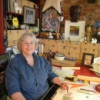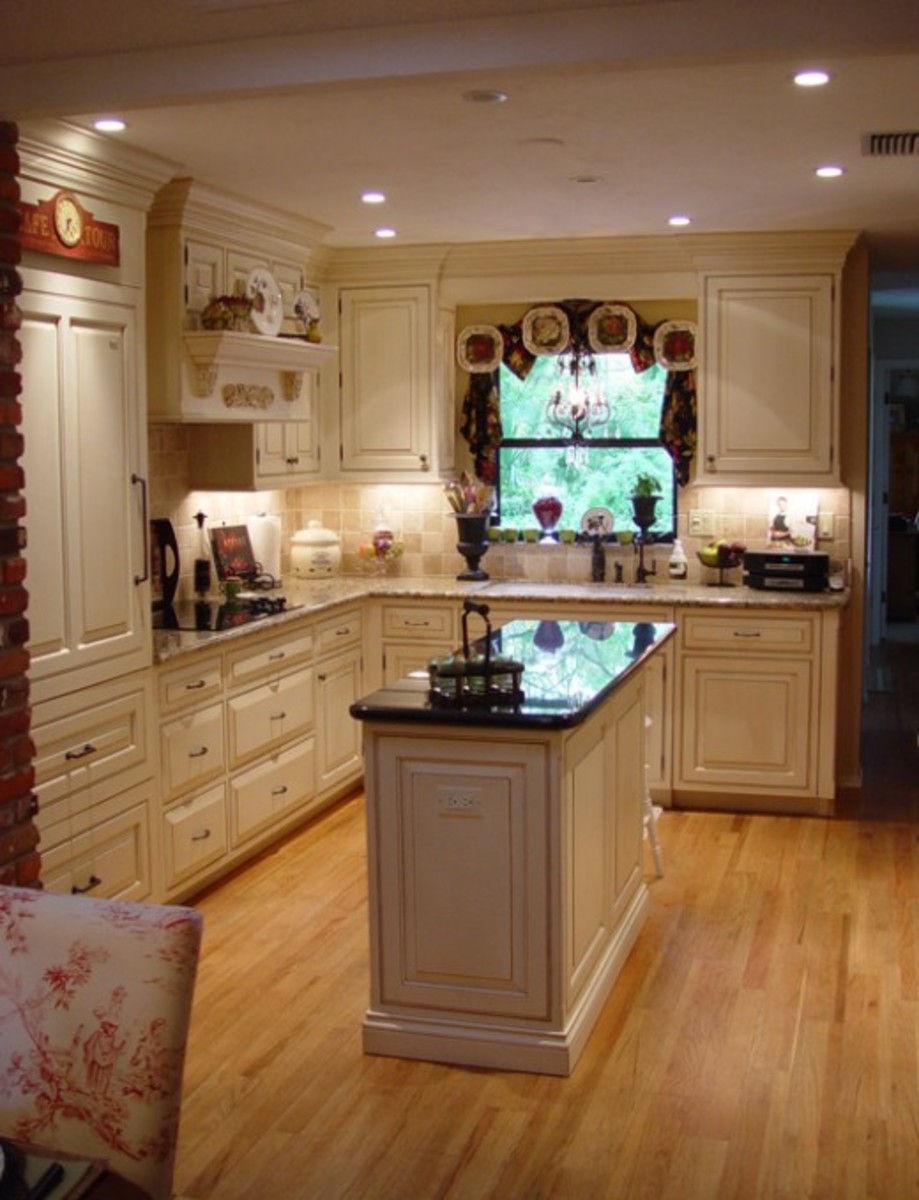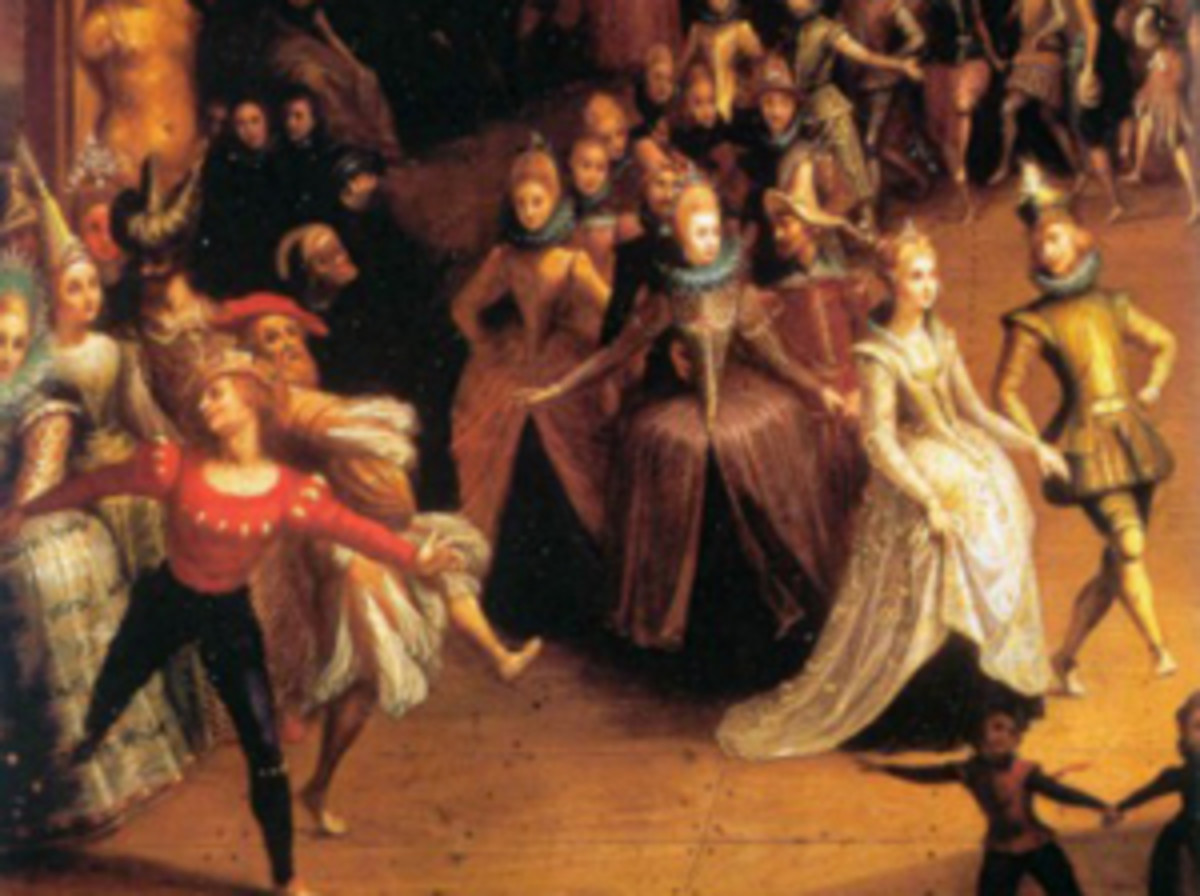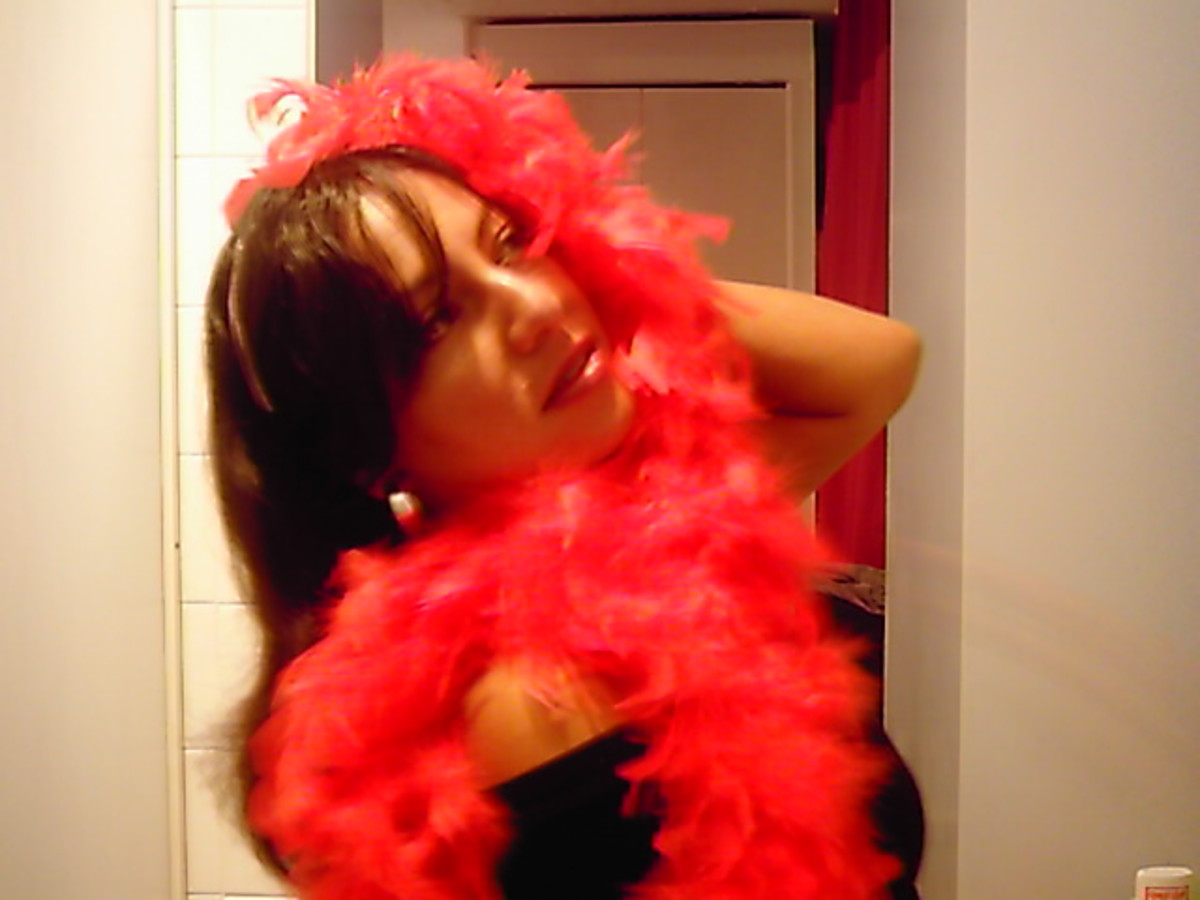3 More Ways to Improve Your Theater Set
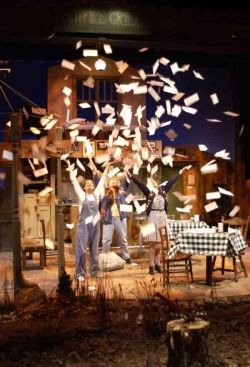
More Than Walls ----- You Want WAHOO!
If you're visiting this new Lens after reading
"3 Ways to Improve Your Theater Set" then welcome! Glad to have you.
In this installment of the Set Self-Improvement Show we'll talk about adding 3D, Heft, and Definition. And, what's more, we'll define exactly what those ARE. Why you want 'em and how to get 'em.
BUT FIRST -
If, Kind Visitor, you found this Lens first - well, you might like to start with the previous one. Only if you want to - because you're very welcome. But if you DO want to start at, um, the start, then just click below and hey! presto! Scotty will help you out.
PS - The photo above of "The Spitfire Grill" is courtesy of:
- Photographer Mark Oristano
Specializing in theatrical photography and actors' head shots. - WaterTower Theatre
In Addison, Texas
Beam me up, Scotty!
- Three Ways to Improve Your Theater Set
Quick - I missed this lens - I better double-back.
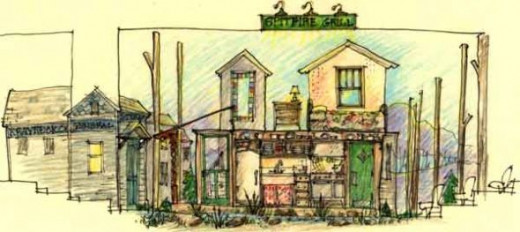

Still Here?
Thanks for coming back for more. What a Trooper!
Last time we talked about some of the basics of designing a set and we worked our way through most of the schematic design phase of sets for three (3) invented plays. We made some assumptions: that our shows would be performed in a normal proscenium space (like on your right) and that these shows were:
--- A modern-day mystery in a country house
--- A tragedy in 1920's Venice
--- A farce in a 1880's New York City tenement.
Each show is a play requiring a single permanent or "unit" set - a more-or-less living room and more-or-less realistic in style.
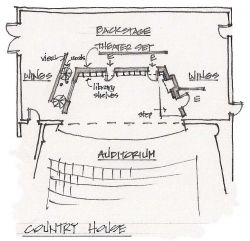
our Country House set
We took our basic set plan (upstage US wall parallel to the proscenium, angled walls at stage right SR and left SL, 3 doors, fireplace location at SL, window(s) at SR) and for the Country House we added a wall of bookcases upstage - filling the whole wall except for the doors. At a single big window we draped a huge (cheap fabric) curtain with a nice tasseled tieback. We talked about a forest view, but what we really did was a sky cyc plus a few actual trees - borrowed Christmas trees and some cardboard carpet tubes painted to look like birch tree trunks. Maybe a little ivy at the windowsill. Did we decide what season it is yet? Ask the director!
At stage left, we added a wide, tall, faux stone (carved foam) fireplace and mounted a deer's head there. We also raised the whole area at SL so that door enters up a step. But we forgot the family portrait didn't we! Let's put that US, hung on the wall of books. The general style is rustic-modern and ski lodge-ish.
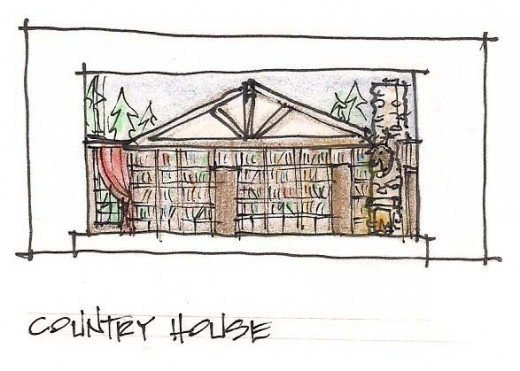
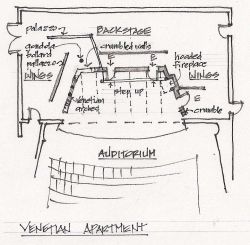
our Venetian Palazzo
This time we modified the basic plan to add a low platform US, so so two doors both enter up a couple steps. We turned our big window at SR into three beautiful Venetian arches that look across a narrow canal to damp, decaying brick walls of other Venetian palaces. We imagined the quiet slap of water and flickering light reflected onto a high, beamed ceiling, but we only installed the beams. (Always try to be nice to your lighting designer.)
At the fireplace, we added a carved stone "hood" - Renaissance style - over the fire. We crumbled away the corners of our room to widen our canal-view and emphasize (in a non-realistic way) our setting's, play's, character's decay. We talked about silvery gray-blue walls and sparse furnishings in order to accent the play's melancholy and loneliness - but you see I added a big tapestry at the center of the US wall. It just needed something. Our budget probably won't stretch to buying a real tapestry - maybe we could borrow one - but how about painting a piece of level-loop (business style) carpet instead? That way we can have a tapestry scene that perfectly fits the theme of our play. The catch to that, of course, is that we'll need a VERY GOOD PAINTER. Start looking!
PS. Start with dark brown or dark gray carpet and paint its surface a la Elvis on velvet.
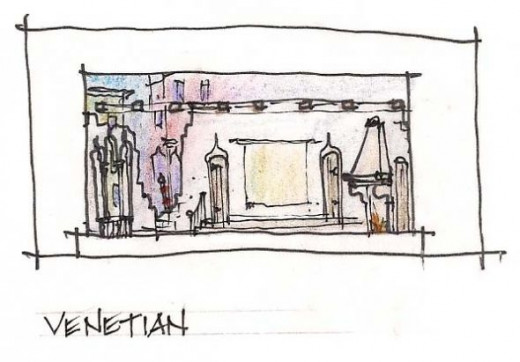
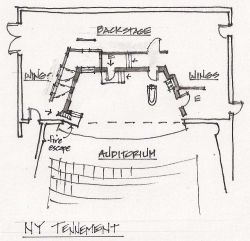
our Tenement
Our tenement looks out on dirty brick walls painted with huge ads (can we see a few letters? a picture? maybe one eye peering in?) There are other tenement windows and clotheslines crowded with colorful washing. In sketching this set, I just sorta added a long line of washing above the set too - it filled out the proscenium opening in a nice way, while keeping the apartment low-ceilinged and claustrophobic. We added an extra window at US, SL - but the fire escape we first put there seemed to make more sense downstage and it seems to have brought yet another window with it.
This makes a fourth entrance - plus we added a hiding place for an actor in the historically correct tub set smack dab in the middle of the kitchen! (This is why you do research, to learn helpful stuff like this.) And at SL, where there used to be a fireplace, we shoved in a stove to use the old flue - a nice touch of building history.
This family wouldn't have had the cash for tapestries, but I could see the mother saving advertising pictures or calendar pictures of pretty views and maybe the dreamer-son might tack up the covers of exciting dime novels?
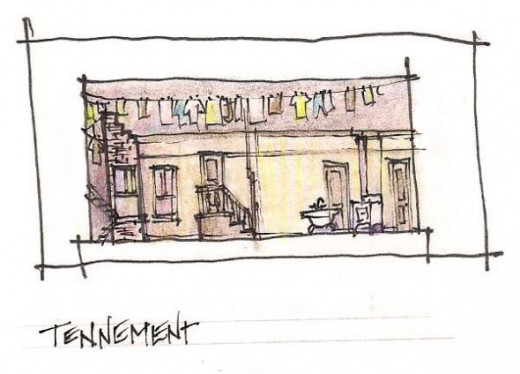

My isn't that sketch crooked!
Remember that it's okay for sketches to look handmade.
In fact, it's a great sales tool to hand draw the sketch right in front of the director if you can - it adds spontaneity and a sort of look-Ma-no-hands! excitement to a design meeting. Brainstorm ideas between yourself - the Designer - and the Director. Collaboration can help and be an awful lot of fun. And sketching helps - it's the designer's first language.
Learning to draw and constantly improving your drawing skills - - - well, it's hard to over-state its importance.
Hie thee to thy sketchbook! (You DO have one don't you? Use it!)
Keep Practicing...
In case you need inspiration to keep on practicing your sketching, watch this great little vid by a woman who wanted to dance - and practiced every day for a year. Amazing! You (and me) can do it too.
- Dance in a Year
A great example of the power of persistence.
Fast Scenic Fix # 9
Carry a Sketch Book!
Find one small enough to carry everywhere.
Take notes, jot down measurements, make lists, sketch ideas, and whenever bored draw anything you can see.
Drawing Paper and Sketchbooks
How can you design without the right tools?


Pencils, pens, and so on - - -
Theater Reference Books
Some basic give-you-background type books.
A Terrific Book
This is an older textbook, but the best I've found to explain every aspect of scenic design (except maybe new-fangled computer drafting). The chapters on scenic painting are wonderfully thorough too. Lots to learn - clearly explained. And there are great interviews with famous scenic designers.
I highly recommend this book.
Having said that, it's out of print so can be hard and expensive to find. I spent about $ 60 dollars on my copy and don't regret it. But you might want to track one down to a local library to look it over before you drop big money on it.

# 4 - Add 3D and Heft
Think of ways to add that third dimension.
The more three dimensional a set is, the more interesting it appears under theater lights. Make sculpture.
Add levels. Varying levels help the director by adding variety of movement and letting all the actors be seen, but levels also just flat make a set more interesting. For this reason, we raised one or more of the entries in all our imaginary sets by at least a few steps. A true two-story (or more!) set is even more fun..
Another way to add 3D is by adding depth. One easy place to do this is in the room's architecture. For instance, the fireplace can jut into the room or be recessed in an alcove. The window could be a bay window with a window seat or could be recessed into a thick stone wall. Doors or bookshelves can be recessed too or beams and architectural moldings can protrude. These strategies add visual interest, but also difficulty to build and add cost, so you'll want to make sure each element is worth the effort to create it. K.I.S.S.

In real life, walls have thickness and columns have to be fat enough to hold up buildings, so add dimension - add thickness - to your set where its needed. On stage, BIG always reads more dramatically than small, so up-size any element you can. For instance, your research taught that New York City tenements often had a bathtub in the middle of the kitchen - residents often put a wooden lid on it to act as a counter top. If you put one in your tenement, make it big, obnoxious, and the focus of your design; this will make it funnier and also irresistible for blocking. Maybe the director will stage the Big Conflict on top of it. I'd almost guarantee that at least one actor will end up standing on it for his Big Speech. Or Big Dance?
"Heft" also means "enough" - don't skimp. Add plenty of balusters or uprights to support stair railings. Skimping on balusters is a common mistake in theater sets and it just screams, "amateur!"
Fast Scenic Fix # 10
What would the real-life walls of your set be built of? How thick is that?
Now make all window and door sills that thick.
How would those materials - brick, stone, wood, etc. - joined?
Make edges or corners of your set look like that.
Research - historic styles
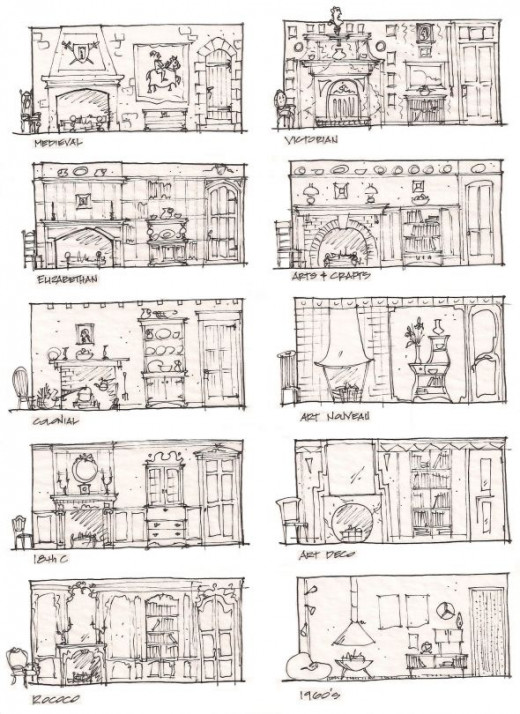
Reference Books
Nothing explains the history of interior design better than a book... with lots of pictures.
This one's a beaut! On British (and rather grand) houses.
A lavishly illustrated book filled with those telling details of historic periods, styles, and construction types. Very useful.


# 5 Add Definition and Specificity
Look at good architecture: corners and edges are often beautifully defined by cornices, crown molding, and trim. Nothing pulls a box set together or makes it look as polished as crisp molding at the ceiling line. This doesn't have to be expensive or fancy - a 1x2 topping an ½" x 8" strip of foam can look great - the important part is that this cap to the wall look crisp, neatly cut (and painted), and be really truly horizontal. What this cap does is perfectly define the top of the set (hiding the uneven tops of flats) and show care in finish and detail. But this trim can be very cheap - cut foam, plywood, even cardboard, or sometimes just a painted stripe will work. All the traditional trims, like baseboard or door and window trim, were first invented to cover construction problems where things didn't quite fit perfectly and that is the job they can do for you on stage. It is better to have plain cheap trim everywhere it's needed, rather than to try to hide problems with tape because you can't afford expensive trim.
Texture problems like uneven or damaged flats is a similar problem which can be solved by making colors darker and less glossy, adding paint texture or mottled color, or in extreme cases covering them with fabric "wallpaper."
Remember to add complexity - where appropriate. The boring default material of modern set building is plywood painted a flat medium color. Anything more interesting than that status quo, can only add to the interest and complexity of a set. Add rough texture: through the grittiness of brick, stone, or stucco; the graininess of weathered wood siding or shingles; or the shagginess of thatch and grass mats. Add other textures - slick like metal, plush like carpet, satiny like polished wood grain, or filmy like fabric - each adds richness. Variegated color also helps - try different paint techniques to enliven that flat wall. Add painted-on aging and dirt.
As you design a room, create an imagined history for it and then leave clues of that history in the set. For instance, that Venetian room would be hundreds of years old, there might be scars on its walls where long ago doors had been bricked in , and there would certainly be stains caused by the dampness of the canal beside it. That tenement would also have water stains because the landlord is too cheap to fix the plumbing - and there would be plumbing, pipes cutting through the apartment on the way to the apartment upstairs. Add those pipes.
Fast Scenic Fix # 11
Make up a biography of your set - what's the history of this room?
Think about how to show some of that.
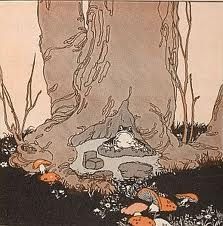
# 6 - Add Character
Always remember which character "owns" this room and think about their personality and psychology. Choose colors, furniture, and objects that they would - or ignore things like bad repair or clashing colors that the character would ignore. ("Grey Gardens" is a wonderful example of this - those characters choose to ignore both building maintenance and hygiene!)
When considering psychology, also look for ways to play with the audience's emotions.
For instance, COLOR can have very strong effects on emotions. Chose the right color and you can sway an audience. The tricky part is that - despite what the gurus of the psychology of color say - HOW color effects people is very individual and quirky. But there are a few rules of thumb that tend to work:
- Hot, reddish colors tend to be exciting and even sexy. They also jump into the foreground of a composition.
- Cool, blueish colors tend to be cooler emotionally too and seem more background.
- Earthy colors tend to feel "earthy" too. (But can be dull on stage.)
Beyond that, the stage has one great advantage in that, because the life of a show and its set is so short, if we use fashionable colors, they'll STAY in fashion, at least during the run. So if turquoise or red or purple is considered sophisticated this week the designer can count on that effect - at least with the more with-it members of the audience. Color can add a lot of character to a set, but remember not to upstage costumes!
Added elements can add character to a set: choose doors, windows, moldings, etc. that are non- standard - find the old, the quirky, or the richly-detailed. Make sure that tenement bathtub has rusty Victorian feet. (For one show where the borrowed "Tub o Death" had no feet, I substituted rubber duckies - it was a comedy. Sorta.) Give the grand fireplace of the Venetian room an impressive family crest carved into the stone. Fill the country house library with deers' heads and a really unusual library table.
Generally, try to use a judicious few really wonderful pieces of furniture or set dressing, "wonderful" meaning not rare or costly, but perfect-for-this-show. Plant your on-stage garden (as i am today) not with the usual green grass, but with the ripe-wheat dry grass of an early Texas spring - because it's the real deal, the truth.
Avoid the generic! Make sure you have a few pieces of absolute reality in your set and honest emotions. Take the following quote as your guide (just substituting the word "design" for "poetry" because art is art.)
"Poetry is the art of creating imaginary gardens with real toads in them."
Marianne Moore.
Go Ye Forth and Design
I hope this Lens has helped - given you a few more questions anyway as you design your theater sets. Break a leg!
(And if you just haven't read enough yet, here are a few links.)
- DeVries Design
My website - Design Diary
My design blog. The topic of the day is always (I hope!) interesting, but check out the Set Design archive for earlier posts on specific issues. - Gifts for Theater Folk
A few suggestions.
Questions on Set Building
- Theater Set Questions Answered
Answers to readers' earlier questions.
Add LOTS of Character
Adding Character doesn't have to mean adding "a lot of stuff"... but in theater, sometimes it does. Here is the set (and some actors!) for a Contemporary Theatre of Dallas production of Steel Magnolias. In the script it explains that the beauty shop is in a converted carport - so as set designer I added a garage door, then had Trudy decorate it with cut out photos of hair-dos. Plus all the equipment and trappings of a hair salon. Voila! Lots o' stuff.
